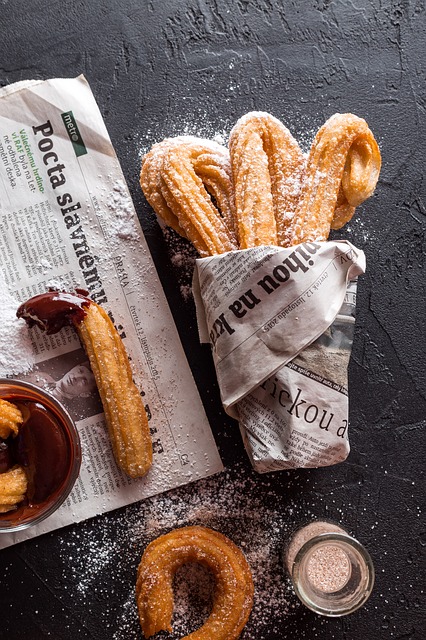There’s something irresistibly comforting about a warm churro crisp on the outside, tender inside, dusted in cinnamon sugar, and begging to be dipped into a cup of thick, velvety chocolate.

It’s one of those rare delights that feels both familiar and exotic, equally at home in a Madrid café or a Yorkshire kitchen on a frosty morning.
But behind this simple pleasure lies a fascinating journey one that spans continents, cultures, and centuries, as with chocolate itself, the story of the churro is one of exchange, adaptation, and a little culinary serendipity.
Our story begins in China with a breakfast staple called yóutiáo a long, golden, lightly salted fried dough stick eaten with soy milk or congee.
In the early 1500s, Portuguese sailors those tireless travellers of the Age of Discovery encountered yóutiáo and were smitten by its simplicity and satisfying crunch.
They brought the idea home, but, being Europeans with a sweet tooth, they made a few modifications.
They swapped the savoury dough for something lighter and added sugar, turning a breakfast side into a dessert.
Instead of yeast, they used a choux-like dough the kind that puffs beautifully when fried giving the pastry its signature crisp shell and airy interior.
When the idea reached neighbouring Spain, the Spanish added their own creative flourish: a star-shaped nozzle.
This piping tip created the ridges we now recognise instantly as “churros,” increasing the surface area for that perfect golden crunch.
A small change, perhaps but one that transformed both the texture and the legacy of the treat.
Another story perhaps more romantic than factual attributes the invention of churros to Spanish shepherds.
Living high in the mountains, far from towns or bakeries, these shepherds made a simple dough of flour, water, and salt and fried it over an open fire.
It was quick, filling, and warming the perfect breakfast before a long day herding sheep.
Legend has it
the name churro came from the Churra sheep, a breed known for its spiral-shaped horns that look strikingly like twisted churros.
True or not, the story captures the spirit of rustic inventiveness that defines Spanish peasant cookery.
Whatever its true beginnings, churros quickly became a Spanish favourite and like many Spanish traditions, they crossed the Atlantic with the conquistadors in the 16th century.
Once in the Americas, they began to evolve, blending with local ingredients and tastes.
In Mexico, churros took on their famous cinnamon-sugar coating, thanks to the abundance of locally grown spices.
Across Latin America, inventive fillings emerged dulce de leche in Argentina, guava paste in Brazil, chocolate in Peru.
Each region made churros its own, a perfect example of culinary adaptation at work.
Chocolate & Churros: A Match Made in Heaven
One of the most delicious cultural pairings in history came when churros met hot chocolate.
When Hernán Cortés brought cacao from the Americas back to Spain, the drink was bitter, spiced, and ceremonial very different from today’s sweet treat.
Spanish chocolatiers transformed it with sugar, cinnamon, and milk, creating a thick, silky beverage known as chocolate caliente.
And what better companion for this rich, molten chocolate than a freshly fried churro?
In Spain, churros con chocolate became a beloved breakfast, a midnight snack, or a post-festival indulgence.
The chocolate is so thick it’s eaten almost like pudding with each churro dipped, twirled, and savoured.
In Madrid, historic churrerías such as San Ginés have been serving this combination for over a century, their marble counters echoing with late-night laughter and the scent of warm oil and cocoa.
The Global Churro Craze
From Europe to Asia, Latin America to the United States, churros have travelled far and adapted everywhere they’ve gone.
In the Philippines, once a Spanish colony, churros are served with tsokolate, a rich local hot chocolate made from roasted cocoa tablets.
In the United States, they became icons of street fairs, carnivals, and theme parks long, golden, and coated in cinnamon sugar, eaten straight from a paper bag.
Modern pastry chefs have gone further still: churro ice cream sandwiches, churro waffles, even savoury churros filled with cheese or spiced with chilli.
Each version keeps that essential joy the contrast of crisp and soft, warm and sweet, comfort and celebration.
A Chef’s Reflection
For me, churros are a reminder of how recipes travel how a simple idea can leap oceans and centuries, shaped by every culture it touches.
They’re also a lesson in culinary curiosity: that a Portuguese sailor’s snack, a Chinese breakfast, and a Spanish shepherd’s ingenuity can all meet in a single bite.
Straight or spiral, dipped in chocolate or dusted with sugar, churros are more than a treat they’re a story of connection, craft, and comfort.
And on a chilly Yorkshire morning, a plate of freshly fried churros with thick cocoa dipping sauce feels like the most delicious kind of time travel.
Chef’s Tip
If you fancy making them at home, pipe your dough through a star nozzle directly into hot oil for those signature ridges and don’t skip the cinnamon sugar while they’re still warm.
For the full Spanish experience, pair them with thick drinking chocolate made from real cocoa and a hint of spice.
